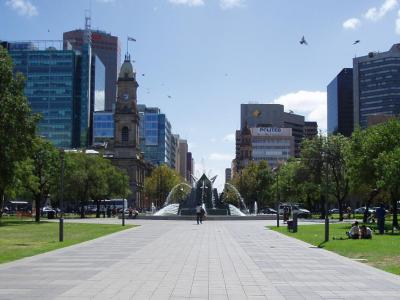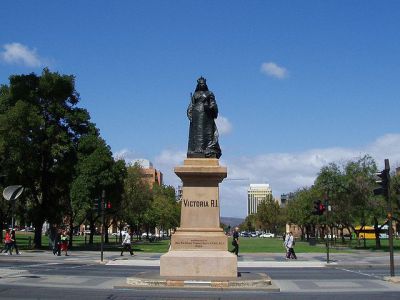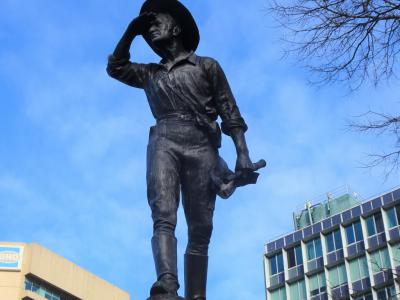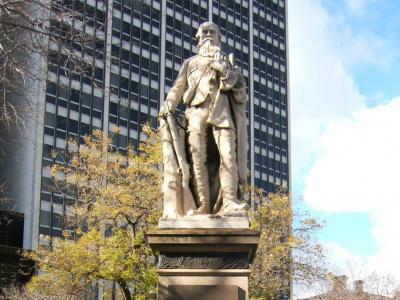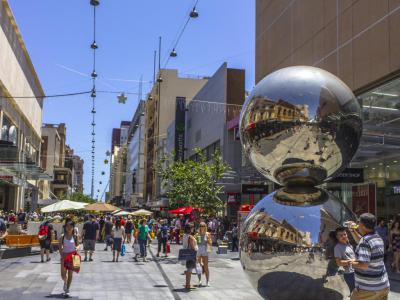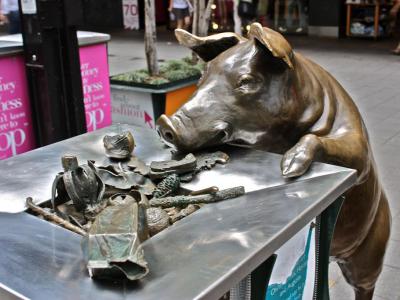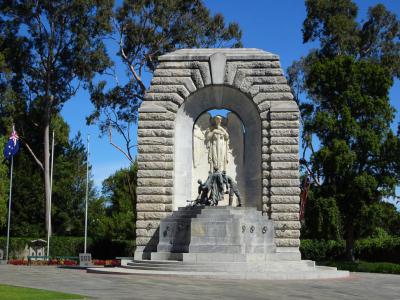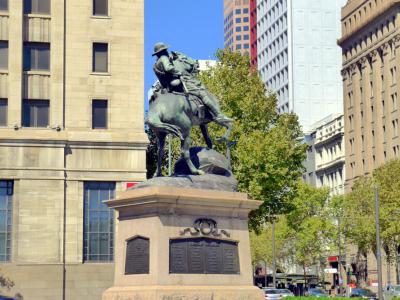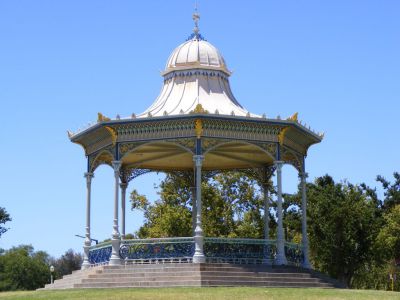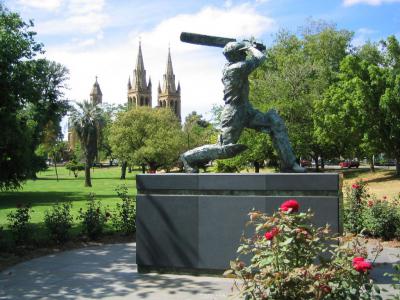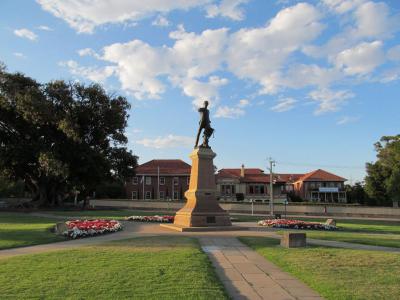Adelaide Squares and Monuments Tour (Self Guided), Adelaide
Adelaide is a modern metropolis with spacious squares, both functional and beautiful, providing flexible spaces for the community and accommodating a variety of activities. There is also a multitude of historical monuments and statues found in the central quarters of the city. Wandering along the cultural North Terrace boulevard, you will pass by some of the most striking of them.
Most of these silent sentinels are of significance to South Australia's development, whether being a noteworthy person who has contributed to the social advancement and fabric of the society (such as Colonel Light, for instance), or a symbol to war (like the Boer War Memorial or the National War Memorial commemorating WW1 heroes) or a sports figure (like the cricket legend Don Bradman).
Most Australian cities have at least one statue of Queen Victoria. Adelaide is no exception and has quite a good one, donated by a brewer, Sir Edwin Thomas Smith, which stands in bronze in a square called, of course, Victoria.
Another notable piece close-by is the Captain Charles Sturt Statue – unlike the staid monuments of other prominent individuals in the Square, this one shows the subject in his working attire – of an outback explorer that he was.
Adelaide's Rundle Mall is a highlight of the South Australian capital. Alongside the historic shopfronts, it has rather quirky, post-Modern Two Balls sculpture (ideal for an unusual selfie), and a cute and novel attraction – Rundle Mall Four Pigs Statues. Apart from the fact they are bronze, these pigs look quite real. You can start a trend and rub their noses for luck!
To appreciate the elegance of Adelaide's squares and memorials, much loved by the locals and tourists alike, and to explore some of the city's outstanding sculptures in more detail, take this self-guided tour.
Most of these silent sentinels are of significance to South Australia's development, whether being a noteworthy person who has contributed to the social advancement and fabric of the society (such as Colonel Light, for instance), or a symbol to war (like the Boer War Memorial or the National War Memorial commemorating WW1 heroes) or a sports figure (like the cricket legend Don Bradman).
Most Australian cities have at least one statue of Queen Victoria. Adelaide is no exception and has quite a good one, donated by a brewer, Sir Edwin Thomas Smith, which stands in bronze in a square called, of course, Victoria.
Another notable piece close-by is the Captain Charles Sturt Statue – unlike the staid monuments of other prominent individuals in the Square, this one shows the subject in his working attire – of an outback explorer that he was.
Adelaide's Rundle Mall is a highlight of the South Australian capital. Alongside the historic shopfronts, it has rather quirky, post-Modern Two Balls sculpture (ideal for an unusual selfie), and a cute and novel attraction – Rundle Mall Four Pigs Statues. Apart from the fact they are bronze, these pigs look quite real. You can start a trend and rub their noses for luck!
To appreciate the elegance of Adelaide's squares and memorials, much loved by the locals and tourists alike, and to explore some of the city's outstanding sculptures in more detail, take this self-guided tour.
How it works: Download the app "GPSmyCity: Walks in 1K+ Cities" from Apple App Store or Google Play Store to your mobile phone or tablet. The app turns your mobile device into a personal tour guide and its built-in GPS navigation functions guide you from one tour stop to next. The app works offline, so no data plan is needed when traveling abroad.
Adelaide Squares and Monuments Tour Map
Guide Name: Adelaide Squares and Monuments Tour
Guide Location: Australia » Adelaide (See other walking tours in Adelaide)
Guide Type: Self-guided Walking Tour (Sightseeing)
# of Attractions: 11
Tour Duration: 2 Hour(s)
Travel Distance: 3.3 Km or 2.1 Miles
Author: Jane
Sight(s) Featured in This Guide:
Guide Location: Australia » Adelaide (See other walking tours in Adelaide)
Guide Type: Self-guided Walking Tour (Sightseeing)
# of Attractions: 11
Tour Duration: 2 Hour(s)
Travel Distance: 3.3 Km or 2.1 Miles
Author: Jane
Sight(s) Featured in This Guide:
- Victoria Square
- Queen Victoria Monument
- Captain Charles Sturt Statue
- John McDouall Stuart Statue
- The Spheres Sculpture
- Rundle Mall Four Pigs Statues
- National War Memorial
- Boer War Memorial
- Elder Park Rotunda
- Don Bradman Statue
- Colonel's Light Vision Statue
1) Victoria Square
Victoria Square is the central square of Adelaide's five public squares. Also known as Tarntanyangga, the 5.9-acre square was created in 1837 by Adelaide founder, Colonel William Light. It was named by the Street Naming Committee after Princess Victoria. The name Tarntanyangga comes from the aboriginal language of Kaurna. It means "red kangaroo."
The square was originally a simple field with four pedestrian paths. Landscaping was added in the mid-19th century, but it remained mostly unchanged until 1894. At this time, a statue of Queen Victoria was added - the princess had become queen by now. Eventually, a statue of Colonel Light, the Three Rivers Fountain and the Aboriginal Flag were all added.
Victoria Square is surrounded by many of Adelaide's most important public buildings. Some of these include the Supreme Court of South Australia, the Federal Court of South Australia and the Adelaide Magistrates' Court. Historic buildings like the former post office, the Roman Catholic Cathedral Church of Saint Francis Xavier and the historic treasury building are also nearby.
One of the most popular traditions in Victoria Square is the installation of an 80-foot Christmas tree each holiday season. It is also a regular spot for political gatherings and community events.
The square was originally a simple field with four pedestrian paths. Landscaping was added in the mid-19th century, but it remained mostly unchanged until 1894. At this time, a statue of Queen Victoria was added - the princess had become queen by now. Eventually, a statue of Colonel Light, the Three Rivers Fountain and the Aboriginal Flag were all added.
Victoria Square is surrounded by many of Adelaide's most important public buildings. Some of these include the Supreme Court of South Australia, the Federal Court of South Australia and the Adelaide Magistrates' Court. Historic buildings like the former post office, the Roman Catholic Cathedral Church of Saint Francis Xavier and the historic treasury building are also nearby.
One of the most popular traditions in Victoria Square is the installation of an 80-foot Christmas tree each holiday season. It is also a regular spot for political gatherings and community events.
2) Queen Victoria Monument
Located in the centre of Victoria Square in Adelaide is the statue honouring Queen Victoria. Victoria's dominion included the Australian colonies, which, after their federation in 1885, made her the monarch of this continent too.
The statue reflects the design originally executed by the English sculptor Charles Bell Birch for the Maharajah of ‘Oodeypore’ [Udaipur] in 1889. Birch later amended the 1889 model and recast the statue of the Queen for the entrance hall of the Imperial Institute in London. It was that amended design that Sir Edwin Thomas Smith, the future major of Adelaide, noticed whilst on a trip to the UK in 1893 and proposed to the Adelaide City Council as a replica monument for the city.
The statue was cast in England by Moore & Company of Thames Ditton foundry. Smith specified that the bronze for it be made of Australian tin and copper from Wallaroo Mine or Moonta Mine; eventually the copper from Wallaroo was used. The red granite base and pedestal for the statue were designed by Mr Smeaton and quarried from the land near Palmer, South Australia. Carving of both did the monumental stonemasons Fraser & Draysey of Waymouth Street, Adelaide.
Inscribed simply with "Victoria R.I.", the statue was originally unveiled by Lady Smith on 11 August 1894. A few years later, it was symbolically draped in black as a sign of mourning following the death of Queen Victoria in 1901. For decades afterwards, a wreath laying ceremony was held at the foot of the monument each 24 May (or 23rd when the 24th fell on Saturday) to mark the anniversary of Victoria's birth in 1819. In May 2013 the statue was temporarily removed, cleaned and polished, as part of the upgrade of Victoria Square, and returned in December 2013 in a modified location.
The statue reflects the design originally executed by the English sculptor Charles Bell Birch for the Maharajah of ‘Oodeypore’ [Udaipur] in 1889. Birch later amended the 1889 model and recast the statue of the Queen for the entrance hall of the Imperial Institute in London. It was that amended design that Sir Edwin Thomas Smith, the future major of Adelaide, noticed whilst on a trip to the UK in 1893 and proposed to the Adelaide City Council as a replica monument for the city.
The statue was cast in England by Moore & Company of Thames Ditton foundry. Smith specified that the bronze for it be made of Australian tin and copper from Wallaroo Mine or Moonta Mine; eventually the copper from Wallaroo was used. The red granite base and pedestal for the statue were designed by Mr Smeaton and quarried from the land near Palmer, South Australia. Carving of both did the monumental stonemasons Fraser & Draysey of Waymouth Street, Adelaide.
Inscribed simply with "Victoria R.I.", the statue was originally unveiled by Lady Smith on 11 August 1894. A few years later, it was symbolically draped in black as a sign of mourning following the death of Queen Victoria in 1901. For decades afterwards, a wreath laying ceremony was held at the foot of the monument each 24 May (or 23rd when the 24th fell on Saturday) to mark the anniversary of Victoria's birth in 1819. In May 2013 the statue was temporarily removed, cleaned and polished, as part of the upgrade of Victoria Square, and returned in December 2013 in a modified location.
3) Captain Charles Sturt Statue
The statue of Captain Charles Napier Sturt (28 April 1795 – 16 June 1869) commemorates the British explorer of Australia, soldier and public servant, who led several expeditions into the interior of the continent from Sydney and Adelaide. The expeditions traced several of the westward-flowing rivers in a bid to determine if there was an "inland sea".
In marked contrast to the staid monuments to Queen Victoria, Charles Cameron Kingston, and John McDouall Stuart, that are also found in Victoria Square, the Sturt monument was considered ‘the most alive’ in Adelaide, when unveiled on 21 December 1916. Standing in the triangular piece of garden in the north-west corner of the square, the life-size bronze statue depicts Sturt leaning forward, shielding his eyes from the sun with a raised right hand, as he peers into the distance.
Appropriately for an outback explorer, he's represented not in the finery, but in the rough clothing – pants and worn knee boots, with the sleeves of his open-necked shirt rolled up to the elbow, and a broad brimmed hat covering his head. In his left hand Sturt carries the tools of trade: a telescope and crumpled map; plus a compass hung on his belt, and a water bottle slung over his shoulder. Fixed to the pedestal (made of Murray River granite and Angasion marble) are the bronze plaques detailing important historical facts about Sturt, his main explorations, and members of his party.
The statue was created by the English sculptor and artist, Adrian Jones, using photographs from Sturt's daughter, Charlotte. The commissioning of the monument was not without controversy though, as Stunt's representation of was not favoured by the committee, but was insisted upon by his daughter.
In marked contrast to the staid monuments to Queen Victoria, Charles Cameron Kingston, and John McDouall Stuart, that are also found in Victoria Square, the Sturt monument was considered ‘the most alive’ in Adelaide, when unveiled on 21 December 1916. Standing in the triangular piece of garden in the north-west corner of the square, the life-size bronze statue depicts Sturt leaning forward, shielding his eyes from the sun with a raised right hand, as he peers into the distance.
Appropriately for an outback explorer, he's represented not in the finery, but in the rough clothing – pants and worn knee boots, with the sleeves of his open-necked shirt rolled up to the elbow, and a broad brimmed hat covering his head. In his left hand Sturt carries the tools of trade: a telescope and crumpled map; plus a compass hung on his belt, and a water bottle slung over his shoulder. Fixed to the pedestal (made of Murray River granite and Angasion marble) are the bronze plaques detailing important historical facts about Sturt, his main explorations, and members of his party.
The statue was created by the English sculptor and artist, Adrian Jones, using photographs from Sturt's daughter, Charlotte. The commissioning of the monument was not without controversy though, as Stunt's representation of was not favoured by the committee, but was insisted upon by his daughter.
4) John McDouall Stuart Statue
The statue of John McDouall Stuart (1815 – 1866) commemorates a Scottish explorer of Australia, one of the most accomplished and famous inland explorers of the continent. During the late 1850s-early 1860s Stuart made several expeditions searching for pastoral country and minerals, exploring vast plains, and ultimately became the first European to have successfully crossed Australia from south to north and back again.
These explorations eventually resulted in the Australian Overland Telegraph Line being built, and the main route from Port Augusta to Darwin being established, which is now known as the Stuart Highway. For his trailblazing exploits, in 1861 Stuart received the gold medal of the Royal Geographical Society.
The statue was built through public subscription (commenced in 1896), and was partly subsidised by the State. The design was submitted by William Maxwell of Adelaide. After he died in 1903, the work was taken over by several men, led by James White of Sydney.
Unsuccessful attempts to find a suitable block of South Australian stone prompted marble being imported from Carrara, Italy. The statue rests on the base of New South Wales trachyte, topped by a bronze frieze featuring a Scottish Thistle. The pedestal features a globe with Australia in polished relief showing Stuart’s route; there are also names of the members of Stuart’s party inscribed on the side.
The unveiling ceremony took place on 4 June 1904 amid controversy. None of the four surviving members of Stuart’s final expedition attended the opening in protest against the selection of Maxwell’s design, arguing that it bore no resemblance to the real man, a “typical bushman he undoubtedly was”.
Despite the furore, or perhaps partly due to it, the memorial proved rather popular. A remembrance ceremony at the statue is held every year by the John McDouall Stuart Society.
These explorations eventually resulted in the Australian Overland Telegraph Line being built, and the main route from Port Augusta to Darwin being established, which is now known as the Stuart Highway. For his trailblazing exploits, in 1861 Stuart received the gold medal of the Royal Geographical Society.
The statue was built through public subscription (commenced in 1896), and was partly subsidised by the State. The design was submitted by William Maxwell of Adelaide. After he died in 1903, the work was taken over by several men, led by James White of Sydney.
Unsuccessful attempts to find a suitable block of South Australian stone prompted marble being imported from Carrara, Italy. The statue rests on the base of New South Wales trachyte, topped by a bronze frieze featuring a Scottish Thistle. The pedestal features a globe with Australia in polished relief showing Stuart’s route; there are also names of the members of Stuart’s party inscribed on the side.
The unveiling ceremony took place on 4 June 1904 amid controversy. None of the four surviving members of Stuart’s final expedition attended the opening in protest against the selection of Maxwell’s design, arguing that it bore no resemblance to the real man, a “typical bushman he undoubtedly was”.
Despite the furore, or perhaps partly due to it, the memorial proved rather popular. A remembrance ceremony at the statue is held every year by the John McDouall Stuart Society.
5) The Spheres Sculpture
The Spheres Sculpture, affectionately known as the “Mall's Balls,” has been a beloved landmark in Adelaide, since its installation in 1977. Situated in Rundle Mall, this iconic piece of public art was donated to the city by the Hindmarsh Building Society to commemorate the opening of the thoroughfare and the society's centenary.
Created by renowned artist Bert Flugelman, the sculpture consists of two large stainless steel spheres, each 2.15 meters (7 feet 1 inch) in diameter, stacked atop one another to reach a height of 4 meters (13 feet). The reflective surfaces of the spheres distort and elongate the reflections of the surrounding streetscape, making it a popular spot for tourist photographs.
Originally titled "On Further Reflection," the sculpture quickly became a well-loved feature of Adelaide's cityscape, so much so that it has seamlessly blended into the public's perception of the space, often overshadowing its identity as an abstract artwork. Locals fondly refer to it as the “Mall's Balls” and frequently use it as a meeting point, with the phrase “I’ll meet you at the Balls” being a common refrain. The image of the spheres has also become a symbol of the city, appearing on various souvenirs, including T-shirts, key rings, and posters.
The construction of The Spheres involved collaboration with the local firm Brister & Company, who crafted the sculpture by welding together the two halves of each sphere and meticulously finishing them through panel beating. Despite some controversy in 2013, when there were discussions about relocating the sculpture during a Rundle Mall upgrade, The Spheres remained in place, continuing to serve as a central gathering spot for Adelaide residents and visitors alike. The Spheres stands as a lasting tribute to Flugelman's artistic legacy and his significant contributions to the cultural fabric of Adelaide.
Created by renowned artist Bert Flugelman, the sculpture consists of two large stainless steel spheres, each 2.15 meters (7 feet 1 inch) in diameter, stacked atop one another to reach a height of 4 meters (13 feet). The reflective surfaces of the spheres distort and elongate the reflections of the surrounding streetscape, making it a popular spot for tourist photographs.
Originally titled "On Further Reflection," the sculpture quickly became a well-loved feature of Adelaide's cityscape, so much so that it has seamlessly blended into the public's perception of the space, often overshadowing its identity as an abstract artwork. Locals fondly refer to it as the “Mall's Balls” and frequently use it as a meeting point, with the phrase “I’ll meet you at the Balls” being a common refrain. The image of the spheres has also become a symbol of the city, appearing on various souvenirs, including T-shirts, key rings, and posters.
The construction of The Spheres involved collaboration with the local firm Brister & Company, who crafted the sculpture by welding together the two halves of each sphere and meticulously finishing them through panel beating. Despite some controversy in 2013, when there were discussions about relocating the sculpture during a Rundle Mall upgrade, The Spheres remained in place, continuing to serve as a central gathering spot for Adelaide residents and visitors alike. The Spheres stands as a lasting tribute to Flugelman's artistic legacy and his significant contributions to the cultural fabric of Adelaide.
6) Rundle Mall Four Pigs Statues
On 3 July 1999, Rundle Mall welcomed new residents - a group of four life-size bronze pigs. The charming squeakers proved so popular with the public that a competition was held to name them as follows: Oliver (the one rearing up to dig through the rubbish bin for food scraps), Horatio (sitting), Truffles (sniffing the ground), and Augusta (observing the other three and greeting passers-by). A pertinent brass plaque with the name of each piggy and the person who named it is fixed accordingly.
Equally loved by children and adults, these cute hoggies, other than being a sheer fun to look at, don't mind being sat on or hugged for pictures. Seemingly indifferent to their celebrity status, they enjoy a great day out on the town, fooling and rooting around.
Created by South African-born, Sydney-based sculptor Marguerite Derricourt, the four grunters, she says, were partly inspired by Pietro Tacca’s 1612 fountain in Florence, Italy, that features the Il Porcellino (“piglet”) bronze sculpture of a boar.
As part of the 2013-2014 Rundle Mall upgrade, the pigs had a “night out” when they literally flew – hoisted by cranes onto trucks for a restoration, prior to being returned to their place on the mall. Some people reckon, the pigs symbolize shoppers sniffing out a bargain.
Equally loved by children and adults, these cute hoggies, other than being a sheer fun to look at, don't mind being sat on or hugged for pictures. Seemingly indifferent to their celebrity status, they enjoy a great day out on the town, fooling and rooting around.
Created by South African-born, Sydney-based sculptor Marguerite Derricourt, the four grunters, she says, were partly inspired by Pietro Tacca’s 1612 fountain in Florence, Italy, that features the Il Porcellino (“piglet”) bronze sculpture of a boar.
As part of the 2013-2014 Rundle Mall upgrade, the pigs had a “night out” when they literally flew – hoisted by cranes onto trucks for a restoration, prior to being returned to their place on the mall. Some people reckon, the pigs symbolize shoppers sniffing out a bargain.
7) National War Memorial
The National War Memorial in Adelaide stands as a solemn tribute to the Australians who fought and sacrificed during the First World War. Opened in 1931, it was the first Australian state war memorial to be confirmed after the war, funded by the State Parliament of South Australia. Despite its initial focus on honoring the nearly 35,000 South Australians who served and the more than 5,000 who fell in "The Great War," the memorial was designated as the "National War Memorial," a title that was already associated with the memorial to the South African War of 1899–1902.
Designed by the architectural firm Woods, Bagot, Jory & Laybourne-Smith, the memorial is a masterful blend of architecture and sculpture. It features marble reliefs and bronze statues by Rayner Hoff, depicting two key scenes: the prelude and epilogue of war. These scenes encapsulate the youthful willingness to serve and the profound sacrifices made, emphasizing not a material victory, but a victory of the human spirit.
The construction of the memorial began in 1928, using marble sourced from Macclesfield and Angaston. By the time of its unveiling in 1931, it became the fourth state World War I memorial to be opened in Australia. In 2001, on its 70th anniversary, the memorial underwent a significant restoration project to preserve its bronze and stonework details and reinforce its foundations, ensuring that it continues to serve as a powerful reminder of the cost of war.
Designed by the architectural firm Woods, Bagot, Jory & Laybourne-Smith, the memorial is a masterful blend of architecture and sculpture. It features marble reliefs and bronze statues by Rayner Hoff, depicting two key scenes: the prelude and epilogue of war. These scenes encapsulate the youthful willingness to serve and the profound sacrifices made, emphasizing not a material victory, but a victory of the human spirit.
The construction of the memorial began in 1928, using marble sourced from Macclesfield and Angaston. By the time of its unveiling in 1931, it became the fourth state World War I memorial to be opened in Australia. In 2001, on its 70th anniversary, the memorial underwent a significant restoration project to preserve its bronze and stonework details and reinforce its foundations, ensuring that it continues to serve as a powerful reminder of the cost of war.
8) Boer War Memorial
The South African War Memorial, commonly known as the Boer War Memorial, is a significant equestrian statue located in Adelaide. This memorial honors the 1,531 South Australians who served in the Second Boer War from 1899 to 1902, marking the first conflict in which South Australians participated. Of those who served, 59 lost their lives, and their names are inscribed on bronze plaques on each side of the 12-foot granite pedestal.
The granite for the pedestal was sourced from Murray Bridge, a town near Adelaide, and the construction budget of £2,500 was raised through public donations. The memorial was designed by the London-based sculptor Adrian Jones, known for his work on military subjects. While the rider depicted in the statue was not intended to represent any specific soldier, there is evidence that the head of the figure was modeled after George Henry Goodall, a South Australian veteran of the war. Goodall, who served as a Regimental Quartermaster Sergeant, advised Jones on the correct portrayal of Australian soldiers' attire and attitude. Despite the facial likeness to Goodall, he modestly insisted that his selection as a model was not due to any particular distinction in his military service.
The memorial was unveiled by the Governor of South Australia, George Le Hunte, on 6 June 1904. Over time, it has become a central feature of the city's Anzac Day commemorations and is recognized as one of Adelaide's most striking and important statues. In recognition of its cultural and historical significance, the Boer War Memorial was added to the national heritage listing in 1990.
The granite for the pedestal was sourced from Murray Bridge, a town near Adelaide, and the construction budget of £2,500 was raised through public donations. The memorial was designed by the London-based sculptor Adrian Jones, known for his work on military subjects. While the rider depicted in the statue was not intended to represent any specific soldier, there is evidence that the head of the figure was modeled after George Henry Goodall, a South Australian veteran of the war. Goodall, who served as a Regimental Quartermaster Sergeant, advised Jones on the correct portrayal of Australian soldiers' attire and attitude. Despite the facial likeness to Goodall, he modestly insisted that his selection as a model was not due to any particular distinction in his military service.
The memorial was unveiled by the Governor of South Australia, George Le Hunte, on 6 June 1904. Over time, it has become a central feature of the city's Anzac Day commemorations and is recognized as one of Adelaide's most striking and important statues. In recognition of its cultural and historical significance, the Boer War Memorial was added to the national heritage listing in 1990.
9) Elder Park Rotunda
Back in the early 1880s, the Adelaide City Council proposed to dam the River Torrens in order to create a lake and construct a public esplanade to the west of City Bridge. Subsequently, Sir Thomas Elder, a wealthy businessman, pastoralist, parliamentarian and philanthropist initiated plans for a rotunda to be added to the lake side, for public enjoyment. In 1881 he wrote to the council from Scotland, offering to donate one.
Ultimately, Torrens Lake was created in 1881, transformed from a series of muddy waterholes into a navigable body of water, when the weir was opened. The rotunda, octagonal in form, 24 feet in diameter, with spandrels and canopied roof with overhanging eaves, surmounted by a domed cupola and bold finial with cast-iron railings, was fabricated by MacFarlane's Saracen Foundry in Glasgow and shipped over from Great Britain in 1882. The task of erecting it was taken by Charles Farr, who, for that purpose, raised the floor some 18 feet above the original ground level with approach steps of granite.
The Elder Park Rotunda was officially opened on 28 November 1882, with 2,000 guests attending the ceremony. A specially composed piece of music, The Rotunda March, was played at the event by the Adelaide City Council Brass Band.
Ever since then, the rotunda has been a focal point for recreation and entertainment in Elder Park, and a dominant, decorative element of the Torrens Valley, intimately tied to its beautification. The structure offers splendid panoramic view of the Lake, with a fountain and special lighting display, and for many years has been the venue of Saturday concerts. If you stand in the exact centre of the rotunda and clap once, the listening experience will surely surprise you!
Ultimately, Torrens Lake was created in 1881, transformed from a series of muddy waterholes into a navigable body of water, when the weir was opened. The rotunda, octagonal in form, 24 feet in diameter, with spandrels and canopied roof with overhanging eaves, surmounted by a domed cupola and bold finial with cast-iron railings, was fabricated by MacFarlane's Saracen Foundry in Glasgow and shipped over from Great Britain in 1882. The task of erecting it was taken by Charles Farr, who, for that purpose, raised the floor some 18 feet above the original ground level with approach steps of granite.
The Elder Park Rotunda was officially opened on 28 November 1882, with 2,000 guests attending the ceremony. A specially composed piece of music, The Rotunda March, was played at the event by the Adelaide City Council Brass Band.
Ever since then, the rotunda has been a focal point for recreation and entertainment in Elder Park, and a dominant, decorative element of the Torrens Valley, intimately tied to its beautification. The structure offers splendid panoramic view of the Lake, with a fountain and special lighting display, and for many years has been the venue of Saturday concerts. If you stand in the exact centre of the rotunda and clap once, the listening experience will surely surprise you!
10) Don Bradman Statue
Adelaide and cricket go together like horse and carriage, i.e. really bloody well. Cricket fans visiting the city certainly wouldn't want to miss out on a tour of the Adelaide Oval. And when they do, they can't help noticing the Don Bradman Statue outside the stadium. Indeed, this nearly 2.5-metre sculpture, standing on a 1.5-metre stone plinth, is very difficult to miss.
Sir Donald George Bradman (27 August 1908 – 25 February 2001), often simply referred to as "The Don", was an Australian international cricketer, widely acknowledged as the greatest batsman of all time. The cricket legend as he was made Adelaide Oval famous in 1930 after a record-breaking performance. Bradman played for Australia for 20 years and his career test batting average of 99.94 has been cited as the greatest achievement by any sportsman in any major sport.
The bronze statue in his honour, sculpted by Adelaide artist Robert Hannaford, was unveiled on 25 February 2002, one year after Bradman's death. Although Bradman retired from cricket in 1948, he still remains one of the most talked about sports persons of the past century.
As a tribute to this hugely popular icon of Australian cricket, whose reputation grew far beyond the limits of the sport, the Australian Commonwealth Treasury also issued coins with Bradman's image.
Sir Donald George Bradman (27 August 1908 – 25 February 2001), often simply referred to as "The Don", was an Australian international cricketer, widely acknowledged as the greatest batsman of all time. The cricket legend as he was made Adelaide Oval famous in 1930 after a record-breaking performance. Bradman played for Australia for 20 years and his career test batting average of 99.94 has been cited as the greatest achievement by any sportsman in any major sport.
The bronze statue in his honour, sculpted by Adelaide artist Robert Hannaford, was unveiled on 25 February 2002, one year after Bradman's death. Although Bradman retired from cricket in 1948, he still remains one of the most talked about sports persons of the past century.
As a tribute to this hugely popular icon of Australian cricket, whose reputation grew far beyond the limits of the sport, the Australian Commonwealth Treasury also issued coins with Bradman's image.
11) Colonel's Light Vision Statue
The Colonel Light Vision Statue in Adelaide commemorates Colonel William Light (1786–1839), a distinguished soldier, sailor, linguist, musician, and painter who played a pivotal role as the first surveyor-general of Adelaide. Colonel Light is widely celebrated for his innovative design of the city's grid-like layout, surrounded by parklands, a plan famously known as "Light's Vision." This visionary urban design was remarkably ahead of its time and remains a defining feature of Adelaide.
The bronze statue of Colonel Light, sculpted by Scottish artist William Birnie Rhind, depicts him in the uniform of the British Royal Engineers, though recreating the 1830s uniform caused delays. The statue stands on a pedestal made of grey and Murray Bridge red granite. The front inscription highlights Light's role in planning Adelaide, while the back features a wreath from the 1917 Australian town planning conference and an excerpt from Light's journal, ironically thanking his critics for the responsibility of choosing the city's location.
Initially installed in Victoria Square in 1906, the statue was later relocated in 1938 to Montefiore Hill, coinciding with the centenary of Light's death. For many years, the statue of Colonel Light stood with his right arm extended, pointing towards the city below, with a map in his left hand. According to local legend, this gesture mimics the moment in 1837 when Light stood on Montefiore Hill, declaring, "This is the place for a city."
The bronze statue of Colonel Light, sculpted by Scottish artist William Birnie Rhind, depicts him in the uniform of the British Royal Engineers, though recreating the 1830s uniform caused delays. The statue stands on a pedestal made of grey and Murray Bridge red granite. The front inscription highlights Light's role in planning Adelaide, while the back features a wreath from the 1917 Australian town planning conference and an excerpt from Light's journal, ironically thanking his critics for the responsibility of choosing the city's location.
Initially installed in Victoria Square in 1906, the statue was later relocated in 1938 to Montefiore Hill, coinciding with the centenary of Light's death. For many years, the statue of Colonel Light stood with his right arm extended, pointing towards the city below, with a map in his left hand. According to local legend, this gesture mimics the moment in 1837 when Light stood on Montefiore Hill, declaring, "This is the place for a city."
Walking Tours in Adelaide, Australia
Create Your Own Walk in Adelaide
Creating your own self-guided walk in Adelaide is easy and fun. Choose the city attractions that you want to see and a walk route map will be created just for you. You can even set your hotel as the start point of the walk.
University of Adelaide Walking Tour
Established in 1874, the University of Adelaide is the third oldest university in Australia. Its main campus on North Terrace, nestled in the cultural heart of the city, adjacent to the Art Gallery of South Australia, the South Australian Museum and the State Library of South Australia, contains some of Adelaide's most iconic and historically significant buildings.
As the earliest home of... view more
Tour Duration: 1 Hour(s)
Travel Distance: 1.1 Km or 0.7 Miles
As the earliest home of... view more
Tour Duration: 1 Hour(s)
Travel Distance: 1.1 Km or 0.7 Miles
Adelaide Introduction Walking Tour
Adelaide, Australia is the fifth most popular city in the country. It is also the capital of the state of Southern Australia. It was settled by the British in 1836 and named after Queen Adelaide, wife of King William IV.
The settlement of Adelaide was inspired by the need for a city made for free colonists rather than convicts. Edward Gibbon Wakefield led this plan. Settlers were given... view more
Tour Duration: 2 Hour(s)
Travel Distance: 3.7 Km or 2.3 Miles
The settlement of Adelaide was inspired by the need for a city made for free colonists rather than convicts. Edward Gibbon Wakefield led this plan. Settlers were given... view more
Tour Duration: 2 Hour(s)
Travel Distance: 3.7 Km or 2.3 Miles
Adelaide's Historical Religious Buildings
Adelaide's religious scene is quite diverse, boasting a wealth of denominations such as Christian (like Catholic, Anglican, Uniting, or Orthodox), Islamic, and others. Quite naturally, over the years this has given rise to a rich tapestry of religious sites, many of which today are considered Australia's heritage.
Among these landmarks is Saint Mary's Catholic Church, an iconic... view more
Tour Duration: 3 Hour(s)
Travel Distance: 6.5 Km or 4 Miles
Among these landmarks is Saint Mary's Catholic Church, an iconic... view more
Tour Duration: 3 Hour(s)
Travel Distance: 6.5 Km or 4 Miles
The Most Popular Cities
/ view all



